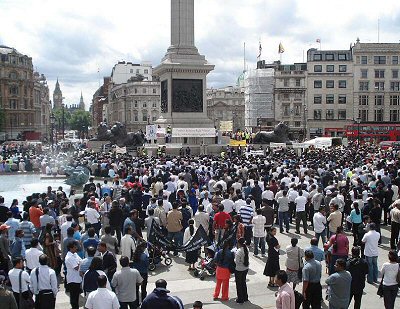Soccer, shells: Life in Sri Lanka rebel north surreal
Soccer spectators roar with excitement as a goal is scored, children play in a nearby park as adults drink tea and an old man cycles slowly along the road. Artillery shells thunder in the distance.
With the front line of renewed civil war just 20 miles (30 km) up the road, residents here in the Tamil Tigers' stronghold in Sri Lanka's far north live a surreal daily diet of fear, desperation and hope.
On closer inspection, some of the soccer spectators are wearing the rebels' characteristic striped fatigues and carrying assault rifles. Cyanide capsules hang around their necks in case of capture. Red flags emblazoned with roaring golden Tigers and crossed rifles flap in the wind.
Some of the players are Liberation Tigers of Tamil Eelam fighters too.
"During the war, we must have a life too," said Anton Anpalagan, a physical education teacher and secretary of the Tamil Eelam Sports Council of the de facto state the Tigers want recognized as independent.
"While the war is going on, at the same time we are looking after the needs of the people and after sports development," he added. "Football is the best kind of counseling for those traumatized by the war."
Residents have had to adapt to a two-decade war that has killed nearly 70,000 people. The sound of war is never far away. Ruins of shelled buildings stand testament to past fighting, sections of wall still pockmarked by bullets and shrapnel.
But a near four-year stint of peace before a 2002 ceasefire broke down last year has given civilians a taste of what life could be like, and they long for the conflict to end.
New buildings have sprouted up housing shops and trappings of the Tigers' de facto state - a law court, customs house and even a consumer price control department.
A government embargo on a host of goods from gasoline to cement coupled with disrupted trade due to the partial closure of the 'border' that separates government and Tiger-held territory is making life a misery for many.
Some have improvised as in earlier stages of the conflict, running their mopeds or cars on a mixture of kerosene and gasoline. Civilians cook with firewood because cooking gas canisters are also barred. Drinkable beer is another casualty.
Prices have sky-rocketed. Petrol costs 550 rupees ($4.90) a liter on the black market in a district where 70 percent of the population earns less than $1 a day. The same liter of petrol costs around 110 rupees in the government-held south.
FED UP WITH WAR
"Business is down because the road is closed," said 57-year-old fruit seller Subramaniam Rajeshwari, tending her stall in Kilinochchi market. "People here are living in fear. Everyone here wants peace. That's what they're hoping for."
Some traders now make just 50 to 60 rupees profit a day, and complain turnover has fallen by more than 70 percent.
The focus of renewed fighting that has killed an estimated 4,500 people since last year has shifted to the north after the military captured vast swathes of territory from the Tigers in the east.
With daily artillery duels across defense lines that sandwich the roughly seven percent of Sri Lanka the Tigers control in the far north, and sporadic air strikes on rebel territory, residents repeatedly displaced by the conflict are bracing for more pain.
"Life is very difficult. It is a very bad situation," said 57-year-old father of four Perumal Kumaravel, a translator who works for one of the handful of aid agencies still operating in Tiger areas.
"I am very worried about the war, the shelling. Kfir (jets) sometimes attack," he said, as he took one of his daughters to watch a musical show planned after the soccer match. "This is not a normal life. Every day I live in fear."
Behind him, LTTE police marshal traffic along the main north-south A9 artery - nicknamed the highway of death because of the deadly battles that have been fought along it.
Posters on a nearby bus stand depict the silhouette of an elite Black Tiger suicide bomber, revered by the secular Tigers as their most powerful weapon. A Toyota pick-up truck in army camouflage colors whizzes past, bristling with rifle barrels.
Some would like to leave but say the Tigers impose restrictions. But still many minority Tamils say they prefer to stay put in rebel areas, fearing persecution if they move to the Sinhalese-majority south.
Some families also fear their relatives will be forced to join the Tigers' war effort as the LTTE seek to boost their numbers by recruiting civilians, some of them against their will.
The Tigers, who have been fighting troops in the north like a conventional army with artillery guns and rocket launchers, have threatened to switch to guerrilla tactics and strike major economic and military targets.
They say peace is impossible with President Mahinda Rajapaksa, who has vowed to wrest control of all LTTE-held territory. Analysts say that sets the stage for a bloody fight for the north, where an estimated 350,000 people live inside LTTE-held terrain, and see no clear winner.
"Let the Tamil people live in their traditional homeland," S.P. Thamilselvan, head of the Tigers' political wing, said in an interview. "Leave the Tamil people without any military occupation or persecution. That will be the day there is no war."










